

Orders of magnitude (power) ~10 zW – tech: approximate power of Galileo space probe's radio signal (when at Jupiter) as received on earth by a 70-meter DSN antenna. 1 aW – phys: approximate power scale at which operation of nanoelectromechanical systems are overwhelmed by thermal fluctuations.[1]100 aW – tech: the GPS signal strength measured at the surface of the Earth,[clarification needed] roughly equivalent to viewing a 25-watt light bulb from a distance of 10,000 miles.[2] 2.5 fW – tech: minimum discernible signal at the antenna terminal of a good FM radio receiver10 fW (−110 dBm) – tech: approximate lower limit of power reception on digital spread-spectrum cell phones 2–15 nW – tech: power consumption of 8-bit PIC microcontroller chips when in "sleep" mode.

Extreme Light Infrastructure. The Extreme Light Infrastructure (ELI) is a new Research Infrastructure (RI) of pan-European interest and part of the European ESFRI Roadmap.
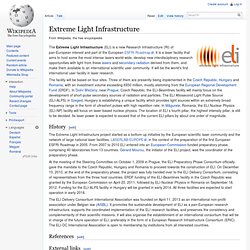
It is a laser facility that aims to host some the most intense lasers world-wide, develop new interdisciplinary research opportunities with light from these lasers and secondary radiation derived from them, and make them available to an international scientific user community. It will be the world's first international user facility in laser research. The facility will be based on four sites. Three of them are presently being implemented in the Czech Republic, Hungary and Romania, with an investment volume exceeding €850 million, mostly stemming from the European Regional Development Fund (ERDF).
ELI : European Project > Extreme Light Infrastructure. World's most powerful laser to tear apart the vacuum of space. Kardashev scale. The Kardashev scale is a method of measuring a civilization's level of technological advancement, based on the amount of energy a civilization is able to utilize.
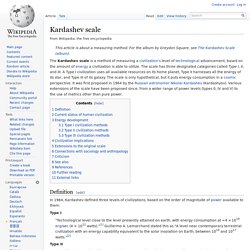
The scale has three designated categories called Type I, II, and III. A Type I civilization uses all available resources on its home planet, Type II harnesses all the energy of its star, and Type III of its galaxy. The scale is only hypothetical, but it puts energy consumption in a cosmic perspective. It was first proposed in 1964 by the Russian astronomer Nikolai Kardashev (Kardashyov). Earth's energy budget. Solar energy as it is dispersed on the planet and radiated back to space.
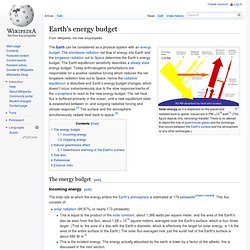
Values are in PW =1015 watt.[1] (The figure depicts only net energy transfer. There is no attempt to depict the role of greenhouse gases and the exchange that occurs between the Earth's surface and the atmosphere or any other exchanges.) The Earth can be considered as a physical system with an energy budget. The shortwave radiation net flow of energy into Earth and the longwave radiation out to Space determine the Earth’s energy budget. Dyson sphere. Dyson sphere is a hypothetical megastructure that completely encompasses a star and hence captures most or all of its power output.

It was first described by Freeman Dyson. Dyson speculated that such structures would be the logical consequence of the long-term survival and escalating energy needs of a technological civilization, and proposed that searching for evidence of the existence of such structures might lead to the detection of advanced intelligent extraterrestrial life. Different types of Dyson spheres correlate with information on the Kardashev scale. Since then, other variant designs involving building an artificial structure or series of structures to encompass a star have been proposed in exploratory engineering or described in science fiction under the name "Dyson sphere". These later proposals have not been limited to solar-power stations. Shell theorem. In classical mechanics, the shell theorem gives gravitational simplifications that can be applied to objects inside or outside a spherically symmetrical body.
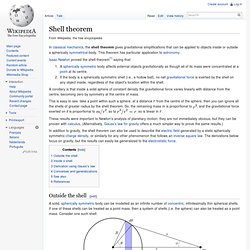
This theorem has particular application to astronomy. Isaac Newton proved the shell theorem[1] saying that: A spherically symmetric body affects external objects gravitationally as though all of its mass were concentrated at a point at its centre.If the body is a spherically symmetric shell (i.e., a hollow ball), no net gravitational force is exerted by the shell on any object inside, regardless of the object's location within the shell. A corollary is that inside a solid sphere of constant density the gravitational force varies linearly with distance from the centre, becoming zero by symmetry at the centre of mass.
This is easy to see: take a point within such a sphere, at a distance. Gauss's law for gravity. In physics, Gauss's law for gravity, also known as Gauss's flux theorem for gravity, is a law of physics which is essentially equivalent to Newton's law of universal gravitation.
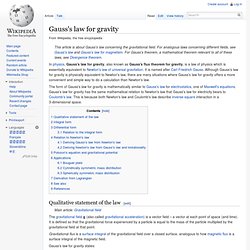
It is named after Carl Friedrich Gauss. Although Gauss's law for gravity is physically equivalent to Newton's law, there are many situations where Gauss's law for gravity offers a more convenient and simple way to do a calculation than Newton's law. The form of Gauss's law for gravity is mathematically similar to Gauss's law for electrostatics, one of Maxwell's equations. Gauss's law for gravity has the same mathematical relation to Newton's law that Gauss's law for electricity bears to Coulomb's law. This is because both Newton's law and Coulomb's law describe inverse-square interaction in a 3-dimensional space. Gravity anomaly. A gravity anomaly is the difference between the observed acceleration of a planet's gravity and a value predicted from a model.
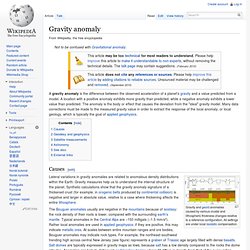
A location with a positive anomaly exhibits more gravity than predicted, while a negative anomaly exhibits a lower value than predicted. The anomaly is the body or effect that causes the deviation from the "ideal" gravity model. Bow shock. LL Ori bow shock in Orion nebula.
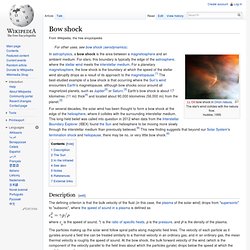
The star's wind collides with the nebula flow. Hubble, 1995 In astrophysics, a bow shock is the area between a magnetosphere and an ambient medium. For stars, this boundary is typically the edge of the astrosphere, where the stellar wind meets the interstellar medium. For a planetary magnetosphere, the bow shock is the boundary at which the speed of the stellar wind abruptly drops as a result of its approach to the magnetopause.[1] The best-studied example of a bow shock is that occurring where the Sun's wind encounters Earth's magnetopause, although bow shocks occur around all magnetized planets, such as Jupiter[2] or Saturn.[3] Earth's bow shock is about 17 kilometres (11 mi) thick[4] and located about 90,000 kilometres (56,000 mi) from the planet.[5]
Megastructure. A megastructure is a very large manmade object, though the limits of precisely how large this is vary considerably.
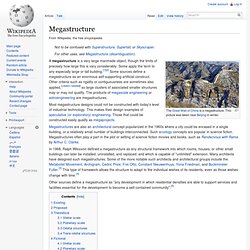
Some apply the term to any especially large or tall building.[1][2] Some sources define a megastructure as an enormous self-supporting artificial construct. Other criteria such as rigidity or contiguousness are sometimes also applied,[citation needed] so large clusters of associated smaller structures may or may not qualify. The products of megascale engineering or astroengineering are megastructures. Most megastructure designs could not be constructed with today's level of industrial technology. This makes their design examples of speculative (or exploratory) engineering. In 1968, Ralph Wilcoxon defined a megastructure as any structural framework into which rooms, houses, or other small buildings can later be installed, uninstalled, and replaced; and which is capable of "unlimited" extension.
Existing[edit] Matrioshka brain. A matrioshka brain is a hypothetical megastructure proposed by Robert Bradbury, based on the Dyson sphere, of immense computational capacity. It is an example of a Class B stellar engine, employing the entire energy output of a star to drive computer systems.[1] This concept derives its name from Russian Matrioshka dolls.[2] Concept[edit] The term "matrioshka brain" was invented by Robert Bradbury as an alternative to the "Jupiter brain"—a concept similar to the matrioshka brain, but on a smaller planetary scale and optimized for minimum signal propagation delay. Computronium. Computronium is a material hypothesized by Norman Margolus and Tommaso Toffoli of the Massachusetts Institute of Technology to be used as "programmable matter," a substrate for computer modeling of virtually any real object.[1] It also refers to a theoretical arrangement of matter that is the best possible form of computing device for that amount of matter.[2] Computronium in popular culture[edit]
Programmable matter. History[edit] In the early 1990s, there was a significant amount of work in reconfigurable modular robotics with a philosophy similar to programmable matter.[2] As semiconductor technology, nanotechnology, and self-replicating machine technology have advanced, the use of the term programmable matter has changed to reflect the fact that it is possible to build an ensemble of elements which can be "programmed" to change their physical properties in reality, not just in simulation. Thus, programmable matter has come to mean "any bulk substance which can be programmed to change its physical properties.
" In the summer of 1998, in a discussion on artificial atoms and programmable matter, Wil McCarthy and G. Snyder coined the term "quantum wellstone" (or simply "wellstone") to describe this hypothetical but plausible form of programmable matter. Transcomputational problem. In computational complexity theory, a transcomputational problem is a problem that requires processing of more than 1093 bits of information.[1] Any number greater than 1093 is called a transcomputational number. The number 1093, called Bremermann's limit, is, according to Hans-Joachim Bremermann, the total number of bits processed by a hypothetical computer the size of the Earth within a time period equal to the estimated age of the Earth.[1][2] The term transcomputational was coined by Bremermann.[3] Bremermann's limit. Bremermann's Limit, named after Hans-Joachim Bremermann, is the maximum computational speed of a self-contained system in the material universe.
It is derived from Einstein's mass-energy equivalency and the Heisenberg uncertainty principle, and is c2/h ≈ 1.36 × 1050 bits per second per kilogram. [1][2] This value is important when designing cryptographic algorithms, as it can be used to determine the minimum size of encryption keys or hash values required to create an algorithm that could never be cracked by a brute-force search. For example, a computer with the mass of the entire Earth operating at the Bremermann's limit could perform approximately 1075 mathematical computations per second. If we assume that a cryptographic key can be tested with only one operation, then a typical 128 bit key could be cracked in under 10−36 seconds. However, a 256 bit key (which is already in use in some systems) would take about two minutes to crack. To evolve into an orthogonal state.[5]
Travelling salesman problem. Tube Challenge. Space fountain. Active structure. An active structure (also known as a smart or adaptive structure) is a mechanical structure with the ability to alter its configuration, form or properties in response to changes in the environment. The term active structure also refers to structures that, unlike traditional engineering structures (e.g. bridges, buildings), require constant motion and hence power input to remain stable. Non-rocket spacelaunch. Present-day launch costs are very high – $2,500 to $15,000 per kilogram from Earth to low Earth orbit (LEO).
Orbital ring. An orbital ring is a concept for a space elevator that consists of a ring in low Earth orbit that rotates at above orbital speed, that has fixed tethers hanging down to the ground. The structure is intended to be used for very high speed transportation and space launch. History[edit] In the 1870s Nikola Tesla, while recovering from malaria, conceived a number of inventions including a ring around the equator, as recounted in his autobiography My Inventions (1919): "Another one of my projects was to construct a ring around the equator which would, of course, float freely and could be arrested in its spinning motion by reactionary forces, thus enabling travel at a rate of about one thousand miles an hour, impracticable by rail.
The reader will smile. The issue was presented by Soviet engineer G. Anatoly E. Launch loop. Launch loop. (Not to scale). The red marked line is the moving loop itself, blue lines are stationary cables. Technology readiness level. NASA Technology Readiness Levels Technology readiness levels (TRLs) are measures used to assess the maturity of evolving technologies (devices, materials, components, software, work processes, etc.) during its development and in some cases during early operations.
Generally speaking, when a new technology is first invented or conceptualized, it is not suitable for immediate application. Ram accelerator. A ram accelerator is a device for accelerating projectiles to extremely high speeds using jet-engine-like propulsion cycles based on ramjet and/or scramjet combustion processes. It is thought to be possible to achieve non-rocket spacelaunch with this technology.
Stellar engine. Dyson spheres in popular culture.